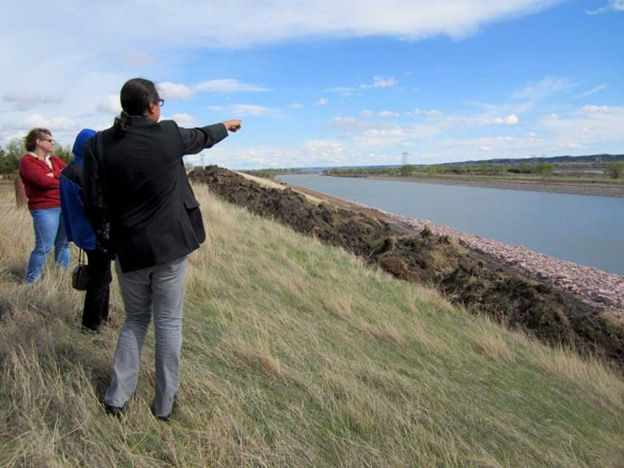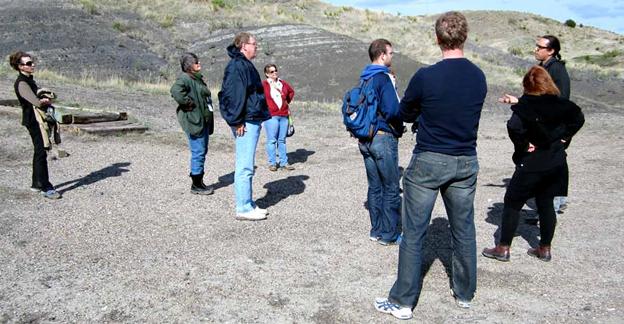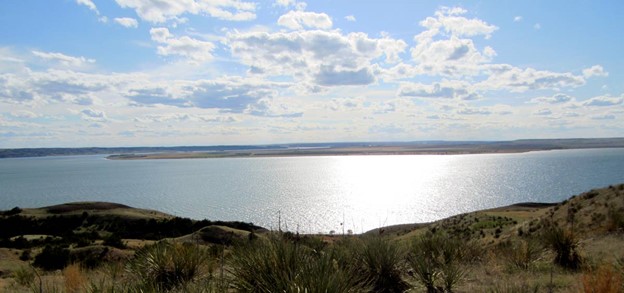Asking the Author: Nick Estes on Tribal History, Writing the 2022 One Book SD ‘Our History is the Future’
March 3, 2022

Estes Comes From Long Tradition of Indigenous South Dakota Writers
Book clubs around South Dakota are reading and discussing Nick Estes’ Our History Is the Future: Standing Rock Versus the Dakota Access Pipeline, and the Long Tradition of Indigenous Resistance. To help readers better understand Estes and his book, SDHC asked Estes to answer questions about himself and how Our History is the Future came to be.
How did this book come about?
This book was written for my 16-year-old self. I didn’t have any knowledge of Native writers or Native books, and I especially didn’t have a firm grasp of the history of this land. And so, Standing Rock, in many ways, provided a way to talk about not only current activism but also a long history of settler colonialism in the Missouri River basin and along the river that we call Mni Sose.
This book was over a decade of research, even though the movement itself happened in 2016 and 2017.I was busily doing archival research for my master’s thesis, as well as talking to local tribal knowledge keepers, as well as Indigenous folks, about this particular history of the river, specifically the damming of the Missouri River. But as we know, that played into how the pipeline struggle played out, especially with the role that the Army Corps of Engineers played in mapping the pipeline close by Standing Rock Reservation lands.
What do you hope South Dakotans will take away from reading it?
I hope that South Dakota will understand that the Oceti Sakowin literary tradition precedes the founding of the state and actually precedes the founding of the United States. Our literary tradition, as many people know, was first an oral tradition. So, we have been working with millennia of knowledge since time immemorial.
I just really hope that South Dakotans respect this deep-seated knowledge that’s grounded in not just history but in place. And that conversation is in dire need of happening, especially the way that we understand state and tribal relations that have been historically antagonistic, because of the separate jurisdictional responsibilities and tribal authority and sovereignty, and understanding that is essential for every South Dakotan, whether you’re Indigenous or not.
It is also important to understand that this is a history that everyone alive is responsible for. Even if you may not be responsible for how that history played out in the past, you’re responsible for how it’s taught in the present and in the future.

Has Native American resistance to the DAPL (and the need for it) changed since the book came out in 2019? In other words, do you feel like it has helped the cause?
I would say Native resistance has expanded. For example, a report from the Indigenous Environmental Network that came out last fall found that Indigenous-led movements in Canada and the United States accounted for challenging at least 25 percent of carbon emissions from both Canada and the United States.
That doesn’t mean that they’ve stopped those carbon emissions, but through the various tactics — whether it’s direct action, whether it’s legal challenges — Indigenous movements have successfully questioned about a quarter of carbon emissions from two of the biggest per capita carbon emitters and carbon extractors, and people who have locked in carbon usage through infrastructure projects for generations to come.
So, in that way, I would say that this book is simply highlighting the beginning of an era of the water protector. Even though we know that Indigenous peoples since time immemorial have been protecting water, there’s something different that happened at Standing Rock in 2016. And this book is merely documentation of that.
What do you mean when you say, “Our History is the Future”? What does this statement mean to you from a perspective of tribal philosophy versus Western ideology?
“Our History is the Future” is a statement, and it’s a provocation. It’s a provocation because Indigenous peoples are only allowed to exist in the past. When in fact, many of the prophecies, as I show in the first chapters of the books, were future-oriented prophecies, the Ghost Dance, for example, which wasn’t a Lakota-derived spiritual practice or ceremonial practice.
But the Ghost Dance nonetheless was a future-oriented philosophy, meaning that it was trying to break the colonial condition of reservation life. It was very much a very modern, anti-colonial resistance movement, even though it’s portrayed as a movement that was trying to essentially, quote-unquote, turn back time.
And I think that’s a mischaracterization. In fact, it was a movement that helped inspire not only Lakota people but other Indigenous people throughout the west to get free and give them a vision of freedom. So, in that sense, it was drawing from previous experiences to project a future in which there is justice and freedom. And I think that’s profoundly different than the way that Indigenous people are talked about in the past tense in history books or in mainstream media.
The name “Our History is the Future” really derives from the moment of Standing Rock. That was really talking about the unresolved history of settler colonialism, resource extraction, as well as the continual violation of tribal sovereignty.
And Indigenous rights had evolved over centuries. It wasn’t something new. But in fact, the vision that Indigenous people were putting forward at Standing Rock with the #NoDAPL movement was a universal aspiration, not just for Indigenous people, but the fact that everyone needs to drink water, right? Not just Indigenous people drink water. So, in that sense, it was a future-oriented project to say that the world, humanity, and the non-human world deserve clean water. And that’s a right that everybody should aspire to.
There’s a reason why Indigenous people led that movement, even though anyone could become a water protector. There’s a reason why Indigenous values ground what we understand as water protector identity, and ethics, which is fundamentally different than Western ideology or capitalist ideology, which privileges extraction, exploitation, commodification, and profit over a collective sense of good and living in good relations.
Western ideology privileges a sense of relations that are fundamentally based on property relations, whereas an Indigenous philosophy undergirds the identity of water protectors’ values and relations that are premised on reciprocity and justice.

You talk a lot about settler colonialism in your book. What does settler colonialism look like today? How is that different than in the past?
Settler colonialism is the process by which an invading foreign population seeks to replace Native people and destroy relations that Native people have with the land and the non-human world, as well as with each other. That process evolves over time from outright extermination to modes of dispossession that we see today.
So, for example, even though blood quantum is an archaic, backward, and racist policy, that was introduced to essentially diminish the population of Indigenous people and to also racialize us, according to the white supremacist ideologies of the United States, it has nonetheless become the basis of Indigenous identity, not without its own faults and challenges. Nevertheless, that identity does not reflect Indigenous worldviews and understanding and does not adequately reflect our political understanding of what tribal authority means in the 21st century. Because without people, without Indigenous people, and the diminishment of our tribal populations, there’s essentially no Indians left to live on the land. That’s a form of elimination.
Other forms of elimination have to do with the way that we are racialized, not just through blood quantum but through disappearance. For example, there is very little representation, if any representation, in mainstream media of Indigenous people. And when we are represented, we’re often represented as backward people or people living in the past. We’re never people who live in the future. That doesn’t reflect the experiences that everyday South Dakotans have with Indigenous people, meaning that they live in the present and they have aspirations for the future.
So, in many ways, settler colonialism isn’t just a spatial practice of taking land, though it very much is a spatial practice of taking land because somebody like Ted Turner, who is a billionaire media mogul, owns about 200,000 acres of treaty territory in South Dakota, and he has the largest privately owned buffalo herd, which is mostly in South Dakota as well. So, when we talk about inequality, we can also look at how settler colonialism is based in the amassing of wealth, as well as land, into the hands of a few people, as well as the amassing and the privatization of a sacred animal, such as the buffalo nation. That is not just a spatial practice about the land itself. It’s also a temporal practice, meaning that it attempts to relegate Indigenous people to the past, as well as attempting to take us out of any kind of future of the land itself.
You say, “A tradition is usually defined as a static or unchanging practice.” Why was it important to you to dispel this notion in the book, and how did you do it?
A tradition is often set as something that is unchanging. And I would say that traditions are always changing. And in fact, we selectively choose ancestors as part of a living tradition of the present. So, for example, Indigenous peoples today choose ancestors from the past, whether it’s Vine Deloria, whether it’s Crazy Horse, whether it’s Bea Medicine or Zitkala-Sa — these are Indigenous or Oceti Sakowin thinkers and writers and activists that we choose as our kind of pantheon of ancestors that we draw on to think about how we want to live in the present.
So, they are essentially ancestors from the past, and Indigenous people, water protectors, especially at the #NoDAPL movement, were attempting to become ancestors of the future. So, they’re part of that living tradition that continues from generation to generation.
Which Native American authors have influenced you the most, and why? Were any particularly influential in creating this book?
I’d say that Elizabeth Cook Lynn, the Dakota scholar and writer, influenced and shaped a lot of my thinking and writing as a scholar and as an author. And I would say that, more specifically, the Oak Lake Writers Society, which is a tribal writing group, has also shaped my thinking about how we need culturally relevant and tribally grounded writing, as well as tribally grounded perspectives in how we tell our stories.
For example, you would not write a story about Russia or write a history book about Russian history without perhaps visiting the place, the country that you’re going to, and consulting the resources from that nation. It’s historians, it’s linguistic traditions, its culture and spirituality. But it seems that Indigenous cultures are up for grabs, that anybody can become an expert in our history without understanding the language, the customs, or even understanding the breadth of our literary tradition on our own knowledge basis. So, I would say that people in the Oak Lake Writers Society, whether it’s Lanniko Lee, Elizabeth Cook Lynn, as I mentioned before, Vine Deloria Jr., Edward Valandra, Craig Howe, Kim Tall Bear, Lydia Whirlwind Soldier, Joseph Marshall III, even those who are not alive, such as Charles Eastman and Luther Standing Bear, have all influenced the way that I’ve shaped and thought about this particular project.
What is the importance of literature during this era of instant, at times misleading news reports, social media, instant gratification, and now a pandemic?
I’d say that news media is fast information. And I would say that Indigenous knowledge is slow information, or slow news, meaning that, for generations, Indigenous peoples have known about the existence of boarding schools and the death toll and the violent toll it’s taken on generations of Indigenous youth, where nearly every Indigenous person alive today has been directly affected by the legacy of boarding schools if they survived those institutions.
But it took international news headlines for this country to have, or to begin to have a conversation about the effects of boarding schools, nearly a century after the closing of one of its most notorious off-reservation boarding schools, Carlisle Indian School.
So where are the news headlines to this day when more bodies are being discovered, more graves of children are being discovered at these institutions, whether they’re in Canada the United States? And so, I think the news cycle doesn’t do justice to these kinds of larger cycles of history and these larger understandings of how knowledge is passed down from generation to generation.
What made you want to become a writer?
I became a writer out of necessity, not really by choice.
I have a mixed relationship with writing. Sometimes I find it enjoyable, but I like to read more than I like to write. And I guess I became a writer because of necessity: tribal voices, Indigenous voices are needed in the 21st century, and I’m not doing anything unique. I’m simply just part of a long tradition of storytellers and of writers.
And so, it’s more of an obligation than it is a sort of choice. I think not everyone can become a writer. It takes a lot of practice and commitment. But if you think about writers and famous people from South Dakota, most of those people are Indigenous. And so, I’m just simply continuing that particular tradition.
If you could choose one takeaway from this book to impart to every person who reads it, what would it be?
I just want people to be inspired. I think a lot of the things that we read, books included, as well as social media posts, aren’t inspiring, and they may point out a problem, but they don’t offer stories of everyday people like those at Standing Rock or like those who are part of the long tradition of Indigenous resistance, how everyday people introduce small acts to make big changes, right?
It’s like casting a single stone in a river. And, sure, it makes ripples, but what happens when you cast a million stones? You make tidal waves, you make history, you make waves of history.
And I want that to be the message and the takeaway of this book that this movement’s humble origins, much like many of our movements throughout our history have had humble origins, were started by humble people. And those humble people were the ones who changed history. They seized their own history and changed the future of this planet. And that’s incredible. And that’s something that I think everyone, no matter who you are, whether you’re Indigenous or not, should feel inspired by.
About Nick Estes
Nick Estes, a citizen of the Kul Wicasa Oyate (Lower Brule Sioux Tribe), lives in Minneapolis and works on a variety of podcasts and publications through Red Media, an offshoot of The Red Nation, an Indigenous resistance organization he co-founded in 2014. A former assistant professor of American Studies at the University of New Mexico, he will join the faculty of the American Indian Studies Department at the University of Minnesota next fall. For 2017-2018, Estes was the American Democracy Fellow at the Charles Warren Center for Studies in American History at Harvard University. His first book, Our History Is the Future, places into historical context the Indigenous-led movement to stop the Dakota Access Pipeline.
Learn More About the One Book South Dakota Program
SIGN UP FOR OUR e-UPDATES!